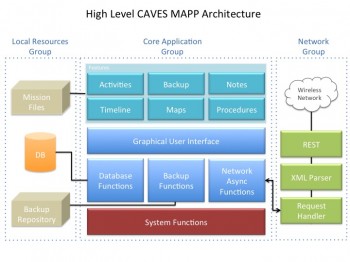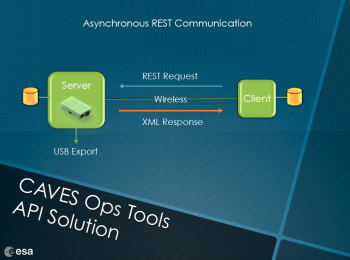 We will present here, for tech-enthusiasts, some more details of the client-side of the OPS tools developed for CAVES 2014 and their supporting hardware. The setup was driven by operational requirements and the peculiarities of the CAVES environment.
We will present here, for tech-enthusiasts, some more details of the client-side of the OPS tools developed for CAVES 2014 and their supporting hardware. The setup was driven by operational requirements and the peculiarities of the CAVES environment.
The in-cave Wi-Fi OPS Support network features a star topology, with a miniature server representing the center element. The server, in particular, works simultaneously as DHCP server, web server, database server, backup repository server as well as Access Point. The main purpose of the network is to allow clients to perform daily backups to a central storage easily, while in future implementations it will be possible to distribute updated OPS products over-the-air to all clients. The hardware choice fell on a Raspberry Pi for the server and Windows 8.1 tablets for asynchronous client use.
The software installed on every client consisted of two applications: the CAVES MApp and the CAVES OPS Backup.
The CAVES MApp is an application that runs on Windows-based devices such as tablets, netbooks or laptops. It provides cavenauts with a visual timeline, maps, their daily activities and points on the map related to those activities. The current implementation of CAVES MApp can also open data-entry documents directly, while future versions will have a dedicated, user-friendly interface for saving scientific data.
The high-level architecture of CAVES MApp consists of three main groups: the Core Application Group, the Local Resources Group and the Network Group.
 The Core Application Group implements user functions and is responsible for the cooperation between the CAVES MApp components as well as acting as an interface with the device hardware and software resources. It includes an engine for the graphical user interface. The Local Resources Group is where CAVES MApp stores, maintains, and retrieves, important mission information. This group interfaces with the Core Application Group via the Database and Backup functions. Lastly, the Network Group is responsible for communications with the server and clients. All network activity is handled via an Asynchronous HTTP-based REST API network service provided by the Network Group.
The Core Application Group implements user functions and is responsible for the cooperation between the CAVES MApp components as well as acting as an interface with the device hardware and software resources. It includes an engine for the graphical user interface. The Local Resources Group is where CAVES MApp stores, maintains, and retrieves, important mission information. This group interfaces with the Core Application Group via the Database and Backup functions. Lastly, the Network Group is responsible for communications with the server and clients. All network activity is handled via an Asynchronous HTTP-based REST API network service provided by the Network Group.
The CAVES OPS Backup application runs in the background on the client hardware and Raspberry Pi server. It automates and simplifies the daily backup procedure. The backups of the Mission Folder from all clients are sent to the server via the OPS Support Lan, including the daily scientific data downloaded from the loggers and manual additions by the CAVEnauts. Once on the server, data are duplicated on a USB drive. The whole procedure does not require more than a few clicks. The USB drive is collected later and handed to the CAVES Ground Support Team for preliminary data analysis.
Alexandros Cardaris, CAVES OPS infrastructure software developer
Alessandro Boesso, CAVES OPS engineer

Discussion: no comments